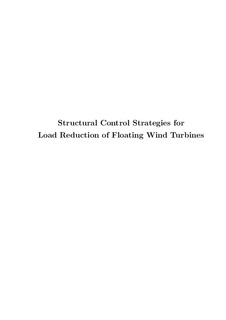| dc.description.abstract | Offshore wind energy has attracted great worldwide attention in recent years, while strong potentials have been found in deep sea areas in many places, such as the coastal lines of the United States, north Europe, and east Asia. According to extensive experiences in offshore industry, floating foundation for wind turbines is considered as an economical and applicable solution. So far, plenty of numerical investigations have been conducted by world-wide research institutions, and different kinds of prototype programs have also been launched, including OC3-Hywind, MIT/NREL TLP, ITI Barge, and Principle Power WindFloat, etc.
One big challenge for floating windmills different from fixed bottom installations is the extra platform motion, which will heavily increase the load on turbine structure due to the high inertial and gravitational forces or even cause the failure of turbine control strategy. Special mechanical design or advanced control technique is required to improve wind turbine reliability, and effective load reduction methods are needed for the design of floating wind turbines. Among different approaches for load mitigation, structural control has offered a direct solution to dynamically compensate the vibrations of turbine structures and reduce their loads.
This dissertation is mainly about the numerical investigations of different structural control ideas for load reduction of floating wind turbines. The state-of-the-art wind turbine simulator FAST-SC (customized for structural control analysis) is used in the simulation analysis, and different scenarios, including the below rated, rated, and parked situations, are considered respectively. Papers A and B are dealing with the parameter optimization problem of a spar-type floating wind turbine equipped with tuned mass dampers (TMDs). The passive structural control devices can either be installed inside the platform (Paper A) or along the nacelle (Paper B). Different performance indices and parameter optimization methods are adopted for TMD parameter determination, including frequency analysis, exhaustive search, and intelligent algorithms. Particularly, a mathematical model for wind turbine surge-heavepitch motion is established based on the D’Alembert’s principle of inertial forces. Paper C investigates the idea of installing tuned liquid column dampers (TLCDs) in floating wind turbines for load reduction, and the code FAST-SCTLCD is implemented based on FAST-SC for fully coupled high-fidelity wind turbine simulation with semi-active structural control channel. Optimal parameters are computed by using genetic algorithm based on the established model, while how to tune the head loss coefficient remains to be investigated. Paper D proposes a gain scheduling H2/H∞ active structural control deign for a hybrid mass damper (HMD) installed at the tower top of a floating wind turbine. The wind turbine dynamic model is improved in this work based on polynomial curve fitting approach, and different steady-state points are derived. The state feedback controller is designed by solving linear matrix inequalities (LMIs). However, full-state feedback controller is technically impossible to implement due to lack of sensors, while the observer-based control design could be a possible solution. Then, Paper E discusses this idea, and an observer-based guaranteed cost structural controller is developed. | nb_NO |

